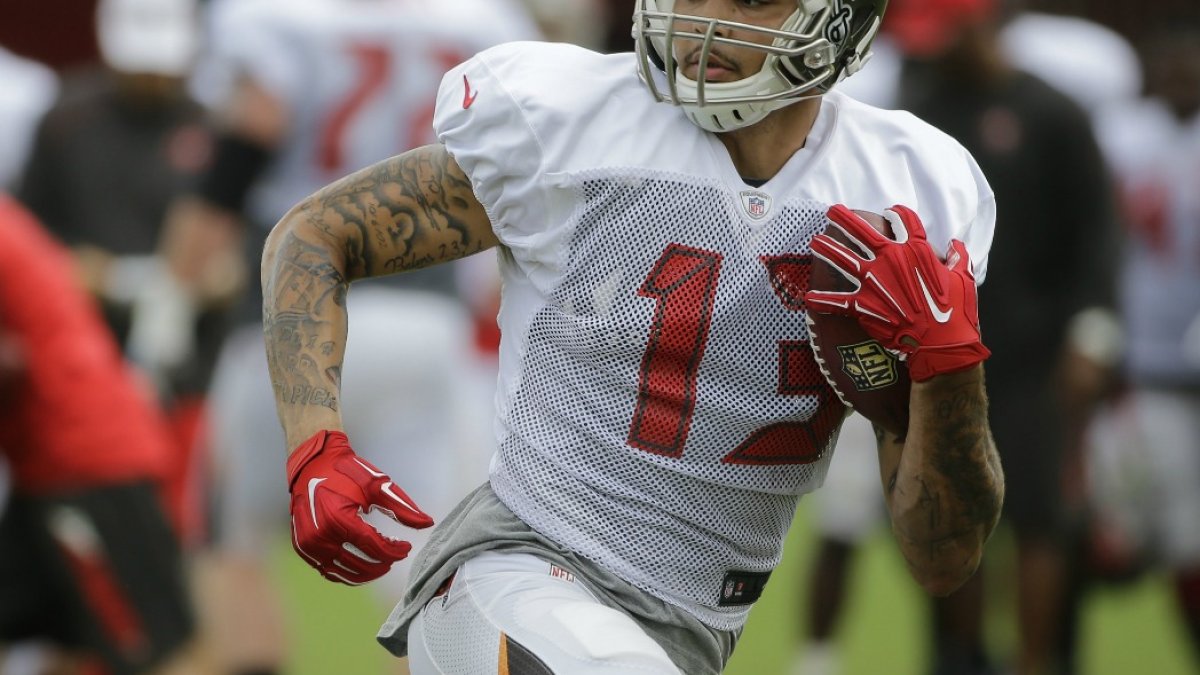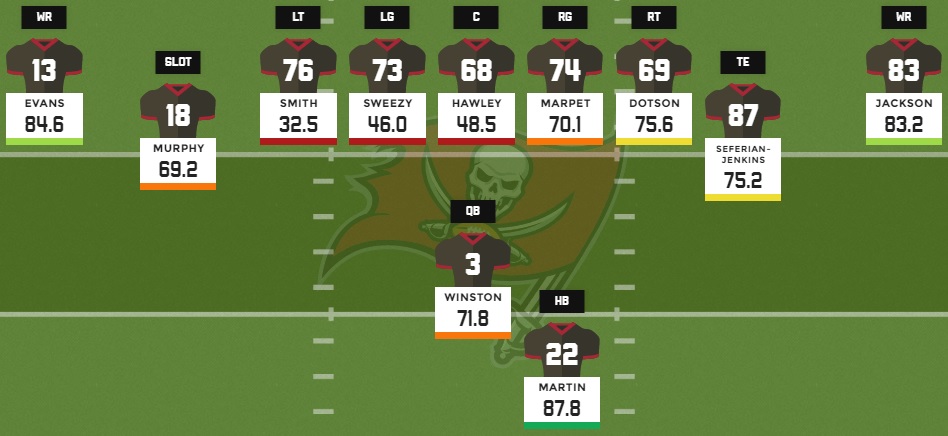(Editor’s note: As we lead up to the season, Director of PFF Fantasy Jeff Ratcliffe is breaking down each team’s depth chart from a fantasy perspective. Catch up on the work so far here.)
With a young roster and new head coach Dirk Koetter, the Tampa Bay Buccaneers are a team that is potentially on the rise. Last year’s Tampa Bay squad ranked fifth in the league in yards per game, which was a significant improvement from their 30th-place finish in 2014.
A big part of the Bucs’ turnaround can be attributed to the No. 1 overall pick in 2015, Jameis Winston. We predicted Winston would top 4,000 passing yards in his rookie season, and we were right. But let’s be clear that it wasn’t a stellar debut season for the former first overall pick. Our analysts ranked Winston as the No. 19 starter at a below-average player grade, and he completed just 58.4 percent of his throws, which ranked lowest among all full-time starters.
But you don’t always have to be great on the field to put up strong fantasy numbers. Winston finished 13th in fantasy scoring, thanks in part to six rushing touchdowns, which was second at the position. Expect this number to regress, as running the football isn’t really part of Winston’s game. Ultimately, it’s a ceiling/floor issue with Winston. He certainly has a borderline QB1 ceiling, but his floor is at the tail end of the QB2s.
Winston’s top target is another former top-10 pick in Mike Evans. Much of the talk surrounding Evans this offseason has dealt with his shaky hands. Sure, he dropped 15 balls last year, but drops tend to be an overrated stat for fantasy purposes. Volume is the name of the game in fantasy football, and only Antonio Brown, Julio Jones, DeAndre Hopkins, and Brandon Marshall saw a higher percentage of their team's targets than Evans did last season. He also tied for fourth in deep targets with 34. Evans is a good bet to remain one of the most heavily targeted receivers in the league. As such, he deserves WR1 consideration on fantasy draft day.
[Looking to draft Mike Evans? Lock in your must-have players and round-by-round targets in PFF's Draft Master tool.]
Veteran Vincent Jackson re-signed with the team in the offseason. Entering his age-33 season, Jackson is far removed from his days as the Bucs' top target. That being said, he's a strong complement to Evans and figures to remain a factor in the Tampa passing game. Let's not forget that he's just one season removed from topping 1,000 yards, and has enough left in the tank for Tampa to resign him in the offseason. He isn't a sexy fantasy pick, but Jackson is a player who is capable of putting up WR4 numbers.
Louis Murphy is the early front-runner for the No. 3 duties. Murphy had an interesting offseason and is coming off a torn ACL. He isn’t likely to surface on the fantasy radar. While second-year man Kenny Bell once looked destined for the job, some believe he’s now on the roster bubble.
The Bucs have some questions at tight end entering training camp. Austin Seferian-Jenkins is a player who generated some fantasy buzz early in the offseason. While there’s a lot to like about the big-bodied tight end out of Washington, he has managed to play just 16 games in his first two seasons, and to make matters worse, Koetter removed Seferian-Jenkins from offseason practice. Seferian-Jenkins is a good bet to be on the Bucs roster in Week 1, but there’s a chance he isn’t the starter. Cameron Brate flashed last season and is certainly in the mix. Seferian-Jenkins’ fantasy arrow is pointing down.
The Bucs especially improved in the run game last year, averaging 135.1 yards per game, which was nearly 50 more yards per game than their 2014 average. To see the fantasy impact of their improvements, we need to look no further than Doug Martin. He finished third in fantasy scoring last year, but was outside of the top-45 in the previous two seasons. To be fair, Martin was banged up in the latter parts of 2013 and 2014, but the difference is still eye-opening. Last year, Martin was one of the most impressive backs in the league, leading the position with 67 missed tackles caused. Only Todd Gurley had runs of 15-plus yards more frequently than Martin. Long runs accounted for 42.1 percent of his yardage total. He also ranked third in yards after contact per attempt.
While Martin is certainly worthy of RB1 consideration, his limited work as a receiver keeps him in the back end of that tier. Charles Sims will continue to serve as the main passing down back. Despite playing a complementary role to Martin, Sims managed to finish tied for 21st in standard scoring and 16th in PPR scoring last season. He didn’t do much damage on the ground, managing just 106 carries and only three games with double-digit carries. However, only six running backs saw more targets, and Sims’ 2.23 yards per route run ranked third among running backs. He was also one of the most elusive backs in the league, forcing a missed tackle on 23.4 percent of his touches last season. Only two running backs forced a missed tackle more frequently. With Martin entrenched as the early-down back, Sims’ fantasy upside is capped in standard scoring. However, he’ll continue to be heavily targeted and makes for a solid RB2 in PPR leagues.
The Bucs addressed their need at pass-rusher with the selection of Noah Spence in April’s draft. Spence isn’t on the IDP radar just yet, but he’s an interesting player who is worth monitoring. Those in DT-required leagues will want to consider Gerald McCoy. He’s a mid-pack DT1. At linebacker, Lavonte David remains entrenched as an elite fantasy option. Second-year man Kwon Alexander had an up-and-down rookie year, but he proved to be a productive IDP asset. Alexander should be considered an LB3-plus.



 © 2024 PFF - all rights reserved.
© 2024 PFF - all rights reserved.